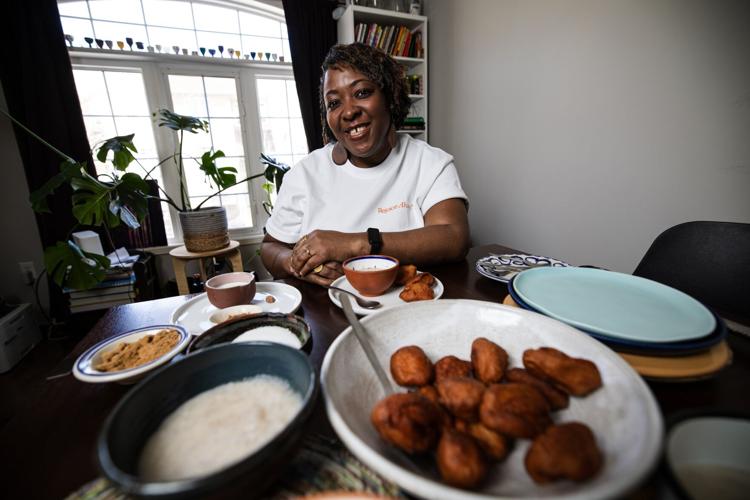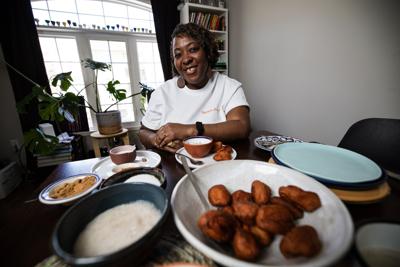Though I eat out for a living, my knowledge of Nigerian cuisine is mostly limited to well-known dishes like jollof and suya. So when Ozoz Sokoh, a food and tourism studies professor and creator of the  blog, told me a few years ago she was working on her debut cookbook, ”,” I was excited for the March 18 release. With more than 100 recipes spanning Nigeria’s six culinary regions, plus insights into the country’s food culture and history, the book is both a cookbook and culinary textbook — crafted by a lifelong home cook tracing the roots and stories behind the dishes she makes.
Sokoh, who teaches at Centennial College’s School of Hospitality, Tourism and Culinary Arts, invited me to her home in Mississauga for freshly fried, fluffy ákárá (bean fritters) and mingau de tapioca (tapioca and coconut pudding) while we talked about the state of Nigerian restaurants in the GTA, how a conversation about food in Brazil led her to explore Nigerian cuisine more deeply, and how writing her cookbook helped her embrace É«É«À² as home.

Àkà rà , fried bean fritters, and bowls of mingau De Tapioca, tapioca and coconut pudding, are two of the recipes featured in Ozoz Sokoh’s debut cookbook, Chop Chop.
Nick Lachance É«É«À² StarHow did you get into food blogging?
I hated my job. I was a geologist in the Netherlands but I couldn’t imagine doing it for the rest of my life.
I’ve always loved cookbooks and food, ever since I was 13. I started cooking and writing recipes in my address book. One Friday night, my ex-partner and one of my best friends were working on their blogs in an open-plan kitchen while I was making Chinese-style fried rice. I thought, ‘I’m a writer, my mom’s an English teacher — I could do this too!’ So, I started my blog in 2008.
I chose the name Kitchen Butterfly because my kids and I would pass by a butterfly garden where we saw the eggs and the chrysalis, and I thought that reflected my journey with food. I didn’t like food as a kid, but in university, I discovered food as a source of comfort. Now, I’m exploring food through its history
Your cookbook starts by explaining Nigeria’s six culinary regions. Was it intimidating to set out to cover such a broad scope?
Two years ago, I spent two-and-a-half months writing the soup chapter. By the time I was done, I had 60, 70 recipes of just Nigerian soups. My parents loved food, so I grew up with half of the book’s recipes. When I moved abroad (to the Netherlands) I saw how other cuisines were documented, and I thought I needed to do a better job documenting Nigerian cuisine. When I moved back to Nigeria in 2011. I wanted to document the everyday foods of the Nigerian, and how we shop, eat, relax, not just the celebration foods.
There’s some foods we call Nigerian foods, foods that every Nigerian knows even though they have regional origins. We know suya is from the north but it’s Nigerian. And then there’s specific regional foods. There’s a sweet fermented rice pancake in the book called masa. I learned about it when I was making a South Indian appam with rice and coconut milk, and someone said it was similar to Nigerian masa.
Also, people know I’m a researcher and have a blog, so they came to me with insights and tips (for the book) as well.

Cookbook author Ozoz Sokoh prepares à kà rà , Nigerian fried bean fritters.
Nick Lachance É«É«À² StarBut when it comes to childhood comforts, which culinary region stands out?
I grew up in Warri, a city on the southern coast. The food from there is my comfort food, in particular pepper soup, which is like a spiced broth. It has a range of indigenous spices and every time I go away, it’s the thing I crave the most. You have , peppercorn, and we use lots of lemongrass, which gives it a mix of citrus and bitterness.
Looking through the sheer number and variety of dishes in your book, which includes desserts, snacks, salads and drinks, I realize most Nigerian restaurants in the GTA have barely scratched the surface. Do you wish there’s more options out there?
I have hopes and dreams, but I also understand the journey of Nigerian food (on an international scale) is still new. My first book proposal was a “New Nigerian Recipes” book and my agent said something that stuck with me. ‘People still don’t know what classic Nigerian cooking is yet. You have to create the foundation first.’ This book is more of a guide to introduce you to the wonders of the culture and cuisine. In Canada, where there’s a lot of different cuisines and dietary preferences, you want to offer a range of dishes that’s broad enough that if people looked elsewhere, they can say, ‘Yes, this is Nigerian.’Â

Àkà rà , fried bean fritters, are prepared by cookbook author Ozoz Sokoh.
Nick Lachance É«É«À² StarI’m glad you live in the GTA because it’s assures me that you can find the ingredients from the book. Where do you shop for Nigerian ingredients?
is my favourite. They deliver in U.S. and Canada. But I can find rice, beans, milk, cornmeal, corn flour, tamarind, at regular grocery stores like a , , the large Chinese grocers. I was looking for smoked mackerel that’s not canned and I found it at ’. South and Central American stores have hibiscus and tamarind. has , but even Cambodian and Vietnamese stores have stuff. I go to for lemongrass leaves. So actually, there’s a lot of overlap with grocers.
I moved from Lagos to É«É«À² in 2020, and I loved writing the book in the GTA. Being able to go to Oceans and find fruits that I’m familiar with, even going to my Metro and finding the d I use. Using the book as a way to discover and learn about the city, it made me feel more at home.
You’re often referred to as a “culinary anthropologist.” Where did that come from?
The team I worked in the Netherlands from 2007 to 2011 was very multicultural. My supervisor, Santiago, is Brazilian and one night we’re having a rijsttafel and we were talking about food from home. He was talking about a fried bean fritter and I thought it sounded like ákárá. He said enslaved West Africans brought it over to Brazil and they call it acarajé.
I was surprised at how much I didn’t know about Nigerian cuisine so that prompted me to find out more. There’s a whole culture and cuisine in Brazil with Nigerian food, and I didn’t realize there are versions of ákárá across the world, so food is more than eating.Â
This interview has been edited and condensed for clarity.































To join the conversation set a first and last name in your user profile.
Sign in or register for free to join the Conversation